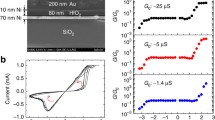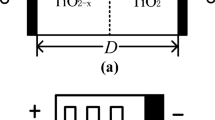Abstract
Imitating the associative intelligence of the biological brain is attractive but is poorly achieved in hardware because the complex tunable connection in neural networks is difficult to reproduce. We develop a circuit composed of a three-terminal memristor network to reproduce the biological conditioning process artificially. The synaptic weight between co-firing neurons is strengthened simultaneously by generating a feedback signal from the integrate-and-fire neuron to the gate of the synaptic memristor. The network allows the multi-associative capacity of recalling more than one digit in one circuit. Both single and multi-associative learning for recalling digital images are achieved. Furthermore, all 10 digital images from “0” to “9” are successfully recalled in an associative network with such paralleling circuits. Assisted by this associative layer, a typical classification network effectively improves the recognition rate for fragmentary digital images. Our work sheds light on brain-inspired artificial associative memory and provides a strategy for applications, such as object recognition with partial features and similar scenes.
Similar content being viewed by others
Explore related subjects
Discover the latest articles and news from researchers in related subjects, suggested using machine learning.References
Kohonen T, Reuhkala E, Mäkisara K, et al. Associative recall of images. Biol Cybern, 1976, 22: 159–168
Kohonen T. Adaptive, associative, and self-organizing functions in neural computing. Appl Opt, 1987, 26: 4910–4918
Hopfield J J. Neural networks and physical systems with emergent collective computational abilities. Proc Natl Acad Sci USA, 1982, 79: 2554–2558
Hopfield J J. Neurons with graded response have collective computational properties like those of two-state neurons. Proc Natl Acad Sci USA, 1984, 81: 3088–3092
Hopfield J J, Tank D W. Computing with neural circuits: a model. Science, 1986, 233: 625–633
Hu S G, Liu Y, Liu Z, et al. Associative memory realized by a reconfigurable memristive Hopfield neural network. Nat Commun, 2015, 6: 7522
Yang J, Wang L, Wang Y, et al. A novel memristive Hopfield neural network with application in associative memory. Neurocomputing, 2017, 227: 142–148
Zhou Y, Wu H, Gao B, et al. Associative memory for image recovery with a high-performance memristor array. Adv Funct Mater, 2019, 29: 1900155
Cai F, Kumar S, van Vaerenbergh T, et al. Power-efficient combinatorial optimization using intrinsic noise in memristor Hopfield neural networks. Nat Electron, 2020, 3: 409–418
Kosko B. Adaptive bidirectional associative memories. Appl Opt, 1987, 26: 4947–4960
Hasan S M R, Siong N K. A VLSI BAM neural network chip for pattern recognition applications. In: Proceedings of International Conference on Neural Networks, 1995. 1: 164–168
Pavlov I P. Conditioned Reflexes. London: Oxford University Press, 1927. 1–448
Yao P, Wu H, Gao B, et al. Fully hardware-implemented memristor convolutional neural network. Nature, 2020, 577: 641–646
Zhu J, Zhang T, Yang Y, et al. A comprehensive review on emerging artificial neuromorphic devices. Appl Phys Rev, 2020, 7: 011312
Zhang W, Gao B, Tang J, et al. Neuro-inspired computing chips. Nat Electron, 2020, 3: 371–382
Fuller E J, Keene S T, Melianas A, et al. Parallel programming of an ionic floating-gate memory array for scalable neuromorphic computing. Science, 2019, 364: 570–574
Wang Z, Wu H, Burr G W, et al. Resistive switching materials for information processing. Nat Rev Mater, 2020, 5: 173–195
Tian B B, Zhong N, Duan C G. Recent advances, perspectives, and challenges in ferroelectric synapses. Chin Phys B, 2020, 29: 097701
Li Y, Lu J, Shang D, et al. Oxide-based electrolyte-gated transistors for spatiotemporal information processing. Adv Mater, 2020, 32: 2003018
Tian B, Liu L, Yan M, et al. A robust artificial synapse based on organic ferroelectric polymer. Adv Electron Mater, 2019, 5: 1800600
Yan M, Zhu Q, Wang S, et al. Ferroelectric synaptic transistor network for associative memory. Adv Electron Mater, 2021, 7: 2001276
Kim M K, Lee J S. Ferroelectric analog synaptic transistors. Nano Lett, 2019, 19: 2044–2050
Niu X, Tian B, Zhu Q, et al. Ferroelectric polymers for neuromorphic computing. Appl Phys Rev, 2022, 9: 021309
Zhou F, Zhou Z, Chen J, et al. Optoelectronic resistive random access memory for neuromorphic vision sensors. Nat Nanotechnol, 2019, 14: 776–782
Lao J, Yan M, Tian B, et al. Ultralow-power machine vision with self-powered sensor reservoir. Adv Sci, 2022, 9: 2106092
Cui B, Fan Z, Li W, et al. Ferroelectric photosensor network: an advanced hardware solution to real-time machine vision. Nat Commun, 2022, 13: 1707
Cai Y, Zhang J, Yan M, et al. Molecular ferroelectric/semiconductor interfacial memristors for artificial synapses. npj Flex Electron, 2022, 6: 16
Wang S, Wang C Y, Wang P, et al. Networking retinomorphic sensor with memristive crossbar for brain-inspired visual perception. Natl Sci Rev, 2020, 8: nwaa172
Rashid T. Make Your Own Neural Network. North Charleston: CreateSpace Independent Publishing Platform, 2016. 105–121
Bu X, Xu H, Shang D, et al. Ion-gated transistor: an enabler for sensing and computing integration. Adv Intelligent Syst, 2020, 2: 2000156
Feng G, Jiang J, Li Y, et al. Flexible vertical photogating transistor network with an ultrashort channel for in-sensor visual nociceptor. Adv Funct Mater, 2021, 31: 2104327
Ren Y, Yang J, Zhou L, et al. Gate-tunable synaptic plasticity through controlled polarity of charge trapping in fullerene composites. Adv Funct Mater, 2018, 28: 1805599
Acknowledgements
This work was supported by National Key Research and Development Program of China (Grant No. 2021YFA1200700), National Natural Science Foundation of China (Grant No. 62174053), Open Research Projects of Zhejiang Lab (Grant No. 2021MD0AB03), Shanghai Science and Technology Innovation Action Plan (Grant Nos. 21520714100, 19JC1416700), Shanghai Pujiang Program (Grant No. 19PJ1402900), and Fundamental Research Funds for the Central Universities.
Author information
Authors and Affiliations
Corresponding authors
Rights and permissions
About this article
Cite this article
Ren, Y., Tian, B., Yan, M. et al. Associative learning of a three-terminal memristor network for digits recognition. Sci. China Inf. Sci. 66, 122403 (2023). https://doi.org/10.1007/s11432-022-3503-4
Received:
Revised:
Accepted:
Published:
DOI: https://doi.org/10.1007/s11432-022-3503-4
Keywords
Profiles
- Chungang Duan View author profile




